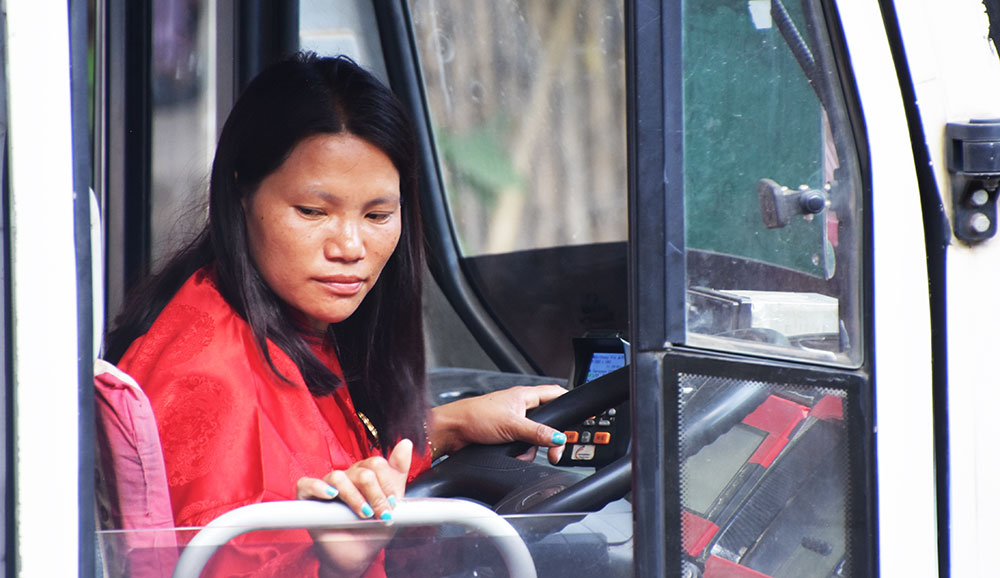Sherab Lhamo
Lobzang Dema, 34, arrives at the bustling city bus office in Thimphu as summer morning sun warmly embraces the city. She walks straight to her bus, with purpose in her stride, unlocking it and getting started on her first chore of the day: cleaning.
Although the city bus service was launched in the late 1990s, the country welcomed its first female bus drivers only last year. Lobzang and six other dedicated women went through eight months of rigorous training, perfecting the art of driving heavy vehicles around the country.
Lobzang, who worked as a city bus conductor for seven years before being laid off owing to the adoption of the smart card system, is now a temporary replacement for male bus drivers.
Lobzang sits easily in the driver’s seat, her dark hair straight and her grin warm. She starts the engine and carefully manoeuvres the bus out of the parking lot, between the other parked vehicles, and onto the vacant road leading to the bus station.
When she arrives at the terminal, she parks the bus in the designated position. Today is her second day as a backup driver, a role she eagerly accepts.
As students scan their cards, a voice from the system says, “Lobthru Gi Shogjang”, and Lobzang greets them with an easy smile and a kind demeanour. Passengers board the bus one by one, and around 7:30am, her first journey of the day begins with a few students on board. As she arrives at the first stop, a group of students eagerly hops onto the bus.
After fifteen minutes, the bus arrives at its third stop near Tashichhodzong and becomes overcrowded with students. Before proceeding, Lobzang checks on the well-being of her passengers through the cross-view mirror, ensuring their comfort and safety.
She arrives at her first stop, Motithang Higher Secondary School, around 8:00am, where pupils scan their cards and disembark. A few kilometres later, she arrives at her second stop near Jigme Namgyel Lower Secondary School, where half of her passengers disembark, leaving only a handful of people on the bus.
Returning to the terminal, she expertly parks the bus and takes a quick break, seizing a moment of respite. Within minutes, her second trip begins, with a small number of passengers on board. As she drives, Lobzang keeps a vigilant eye, scanning left and right to spot any potential passengers hailing for the bus.
She never loses sight of her passengers’ safety while driving, routinely checking on them through the rearview mirror and sticking to road safety regulations.
Lobzang returns to the terminal at 9:15am and takes a short break to count the day’s cash, a routine duty she completes methodically. As she steps off the bus, she treats herself to a nice cup of coffee, savouring the peace and quiet before beginning on her third excursion.
“When I first started driving, people were sceptical,” she says. “They would say, ‘I don’t want to get on this bus because the driver is a woman.’” People became accustomed to seeing us behind the wheel over time, and they no longer care.”
She looks at her watch under a leaden sky with a mild drizzle and realises that noon has passed. Lobzang exits the bus and walks to a neighbouring restaurant to eat her first meal of the day and refill her energy levels. She picks up her bags and walks straight to her daughter’s school, anxious to greet her and stroll back to the terminal.
Being a mother of two and a breadwinner of the family, she says that it’s tough to balance work and life.
Her fifth trip is about to begin.
She approaches her destination at 4:00pm, the bus gradually fills up, reminiscent of the hectic travel earlier in the day. Seats fill up, and the aisles are filled with lively talk and cheerful laughing from students.
It is 6:50pm, Lobzang returns to the terminal. She parks the bus, and allowing a grin to form on her lips, briskly disappears into the terminal office.


